Today Quarq announced their latest creation – the TyreWiz, which monitors your tire pressure on your bike. These small sensors attach to Presta tire values, so basically most bike tires that this target market would care about (mountain, road, fat bikes). From there the unit then transmits your tire pressure second by second to your head unit, be it a Garmin device or a Wahoo ELEMNT/BOLT, or even just your phone.
I’ve been trying this out for the last week on my rides, and have come away pretty intrigued. So I figured I’d dive into all the details on how it works, and perhaps more interesting how I think it could be leveraged down the road. Since it’s not a super complex product, I’ll try and keep this post as streamlined as possible.
The Tech Details:
The TyreWiz kit comes with two sensors in the box, for your two wheels. In the event you have a single-wheeled contraption (looking at you, Ed), you’ll be able to equip two such contraptions. And if you have a three-wheeled device…well, so does my 1 year old (just kidding). There isn’t a one sensor version of the package, which makes sense because monitoring only one of your two wheels doesn’t really make a lot of sense.
Within the box is a somewhat important tool, the valve stem removal tool. This tiny little doohicky allows you to twist out and remove your valve stem. Of course, removing valve stems is hardly new, so if you lose this little thing you can use a wide assortment of methods on YouTube with varying degrees of success.
Which gets us right to that stage – removing the valve stem from your tubes. First, let out the air in your tires, or at least, some of it. I found out interestingly that if you don’t do that and remove the valve stem that your valve stem will eventually depart the bicycle with the speed and fury of a Falcon 9 rocket. It’s impressive actually, it left the kitchen and shot about 8 meters away down a hallway. Ignoring the rocket-assisted removal, the process to take out a valve stem only takes a few seconds.
Once it’s removed you’ll take one of the TyreWiz pods and twist it back on the valve. This will take a long time, perhaps 3-4 seconds, maybe 5 seconds if you want to ensure it’s perfectly aligned.
After which, you’ll go ahead and pump up the tube like you normally would. The top of the TyreWiz is identical to the valve stem that you just removed, so it’s just like normal there. Note that you don’t utilize your old valve stem in this design. Obviously, you probably want to keep it in your toolbox somewhere in case you remove the TyreWiz devices (especially if you have fancier tubes that cost a bunch).
The battery is a CR1632 battery that they claim will last about 300 hours of use. Also, it’s IPX7 waterproofed (so 30 minutes at 1-meter depth), and the weight is 10g each.
Next, you’ll want to get it paired up to the app. Technically speaking this isn’t required if you just use Garmin/Wahoo devices to view the data, but the app allows you to set ‘ranges’ for acceptable tire pressure for your wheels. So without that configuration you’d just get the straight tire pressure.
On the Bike:
Pairing to the mobile app is super simple, you just crack open the app and then spin the wheel to wake up the sensors. From there you’ll see the app has both a front and rear wheel section, where you’ll pair each one individually. Oh, and the pods can have their firmware updated too. You may even notice that the units can be paired via NFC as well.
The actual ID of the sensor is etched into the side of the sensor, making it super easy to figure out which is which.
Next, you can configure your weight and tire size, which will then give you suggested tire pressures. Of course, tire pressure is a super religious thing like tater tots vs onion rings – so this is just a suggestion, not a mandate. You can override it as you see fit via the app, specifying the ranges you want. These ranges then allow the data field, later on, to show when you’re above/below what you’ve specified.
With all that setup, you’ll likely want to get things cookin’ on your head unit. Now I’ve consolidated everything into a single video, so you can see what it looks like from setup to out on the road here:

For now, I’m using a Garmin with it (for the simple reason the Wahoo firmware beta build isn’t quite ready yet, as soon as it is, I’ll include it here). In the case of Garmin, you’re downloading their Connect IQ data field, which is compatible with just about every Garmin Connect IQ watch/head unit you can think of. In my case, I used it on an Edge 1030, Edge 520 Plus, and Edge 520. No issues with any of them. The data field simply shows your tire pressure for both wheels.
If you’ve setup ranges, then it shows that information as well by highlighting when something is out of range:
I’d like to say there’s more to show here, but honestly, that’s it. It just shows your tire pressure in real-time. It’s instantaneous though, in fact, you can see this when pumping up a tire, as it responds instantly to each pump. Super cool (you can see that in my video).
Also note that via the app you can change how you’d like tire pressure to be shown – including PSI, BAR, and Kpa.
Now, behind the scenes, it’s also recording your tire pressure into the .FIT file, so that it shows up later on Garmin Connect, as well as for 3rd parties to access. The earlier beta Connect IQ apps I was using didn’t have the code to write to the .FIT file, so I can’t show you that today. I got the updated beta app about the exact same time I boarded the plane to the US on Monday. But the good news is I’ll be giving these a whirl mountain biking over the next few days at Sea Otter, so I’ll share some data there and post it here. Also note that there is an ANT+ Tire Pressure device profile in the works, making it such that this kind of data can be better standardized.
Further, Quarq says that their Qollector unit now already supports this, enabling you to transmit that data in real-time to others watching over you (or, just recording the data).
Oh – about accuracy. The unit claims “+/- 2% accuracy at .1 PSI resolution”.
While I can’t speak to the accuracy of my bike pump (some sort of Specialized model that says ‘Airtool’ on it), the two matched almost perfectly, within 1PSI, the entire time.
And finally, just to be super clear – this works with mountain bike tires:
Above is some imagery from Quarq showing that, but I’ll capture my own photo goodness tomorrow when I steal someone’s mountain bike at Sea Otter.
Wrap-up:
There will undoubtedly be some that say that spending $199 to know if you’ve got a flat tire is silly. And, I probably wouldn’t disagree. As I noted in the video, I think the sweet spot for this device is $99 for the pair.
That aside, I think there’s some really fascinating data to be had here. Both in the real-time sense, but also in the historical sense. Sure, knowing whether I’ve got a slow-leak in the middle of an Ironman is hugely valuable. And after you’ve spent thousands of dollars to get to that ‘A’ race, another $200 that you’ll use for years probably isn’t horrible.
But I’m actually more interested in the trending data that you can develop with it. For example – what do tire pressure trends look like on a hot day versus a cold day? How quickly does tire pressure decline on rough roads versus smooth pavement? How does that differ between mountain biking versus road biking? If I leave my bike sitting in my garage, how much does the tire pressure decline each day, exactly?
Speaking of precision – exactly how much air/pressure do you lose when you take the pump off the valve and you hear that air spit out? The answer as I found out: Almost nothing, well under 1PSI (I suspect the air you’re hearing is actually from the pump, not your tire). I used the app to figure this out.
I should also note that Quarq isn’t the first looking at this space, in fact, 4 years ago I showed a prototype at Eurobike from Lightweight. And last year at Eurobike, Hutchinson also showed a prototype. Neither though have brought a product to market that’s ready to buy and about to ship.
In any event – I’m looking forward to collecting data over the next month or so to answer some of these questions, which I’ll include in my full in-depth review once the device starts shipping sometime later next month. Plus, by then I’ll hopefully be able to test the Wahoo implementation as well.
With that – thanks for reading!
—
Update: You can now order the TyreWiz from Clever Training. In doing so you help support the site, plus, you can save 10% via DCR Coupon Code DCR10BTF, as well as get free US shipping. Enjoy!


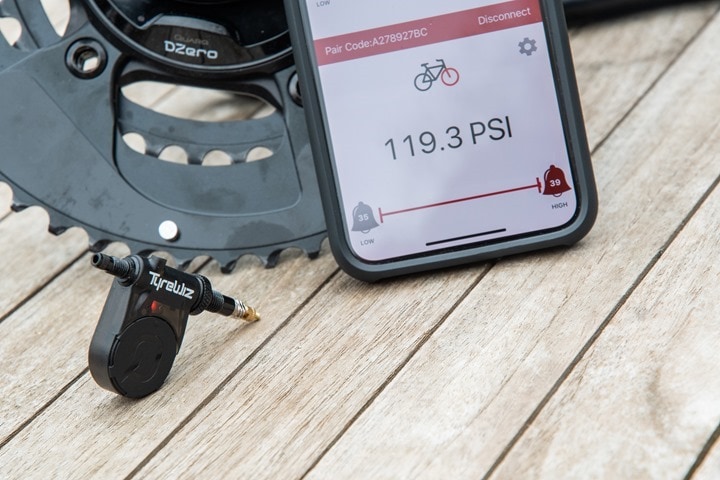
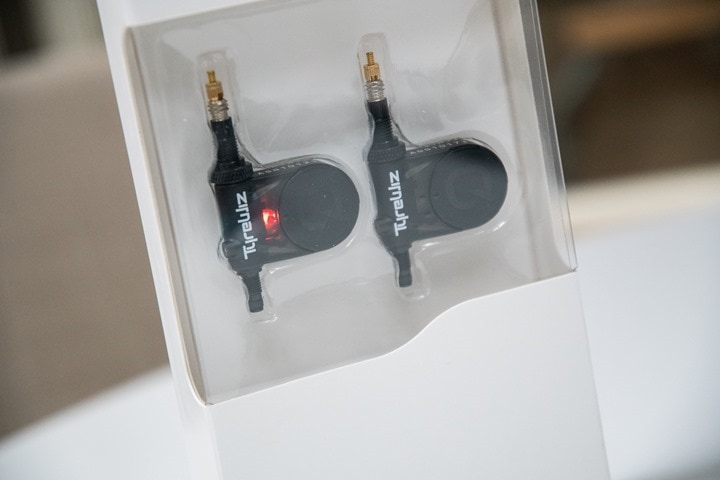
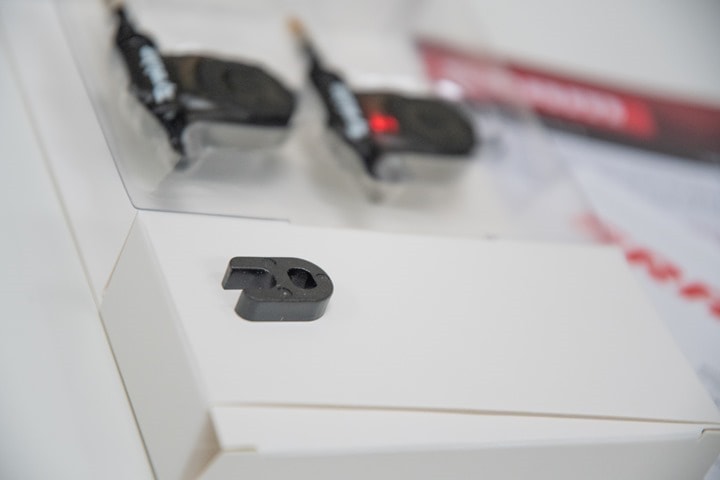
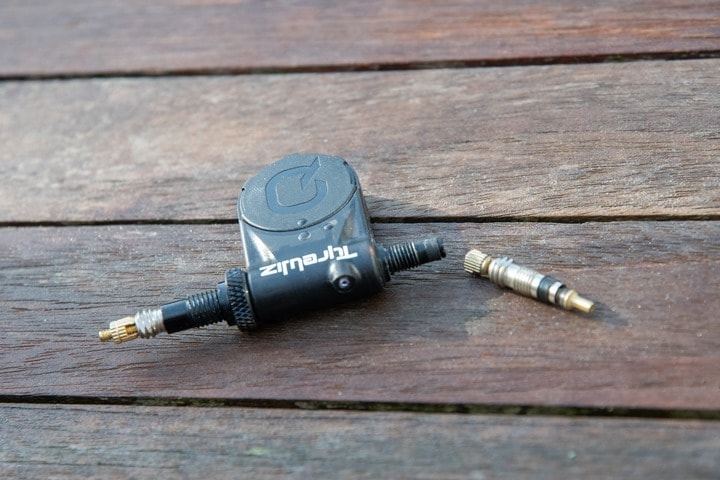

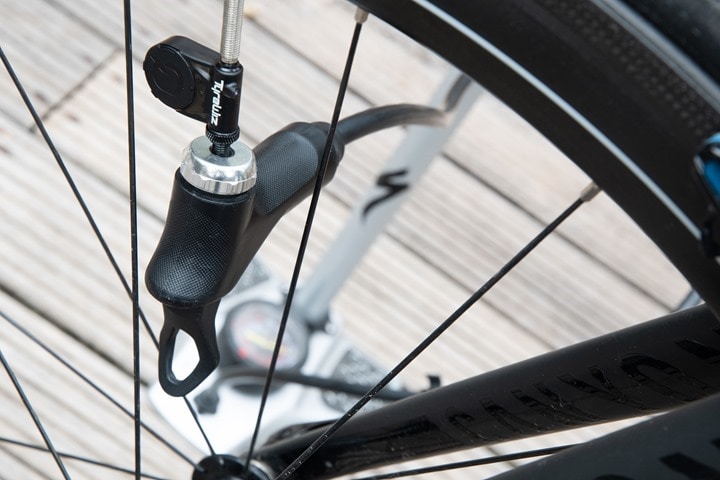



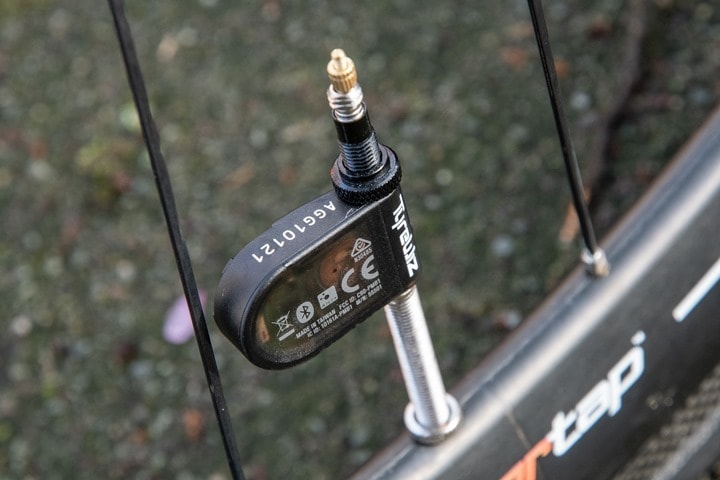
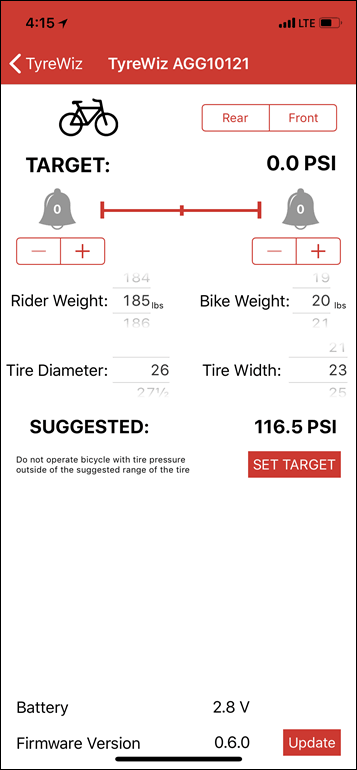

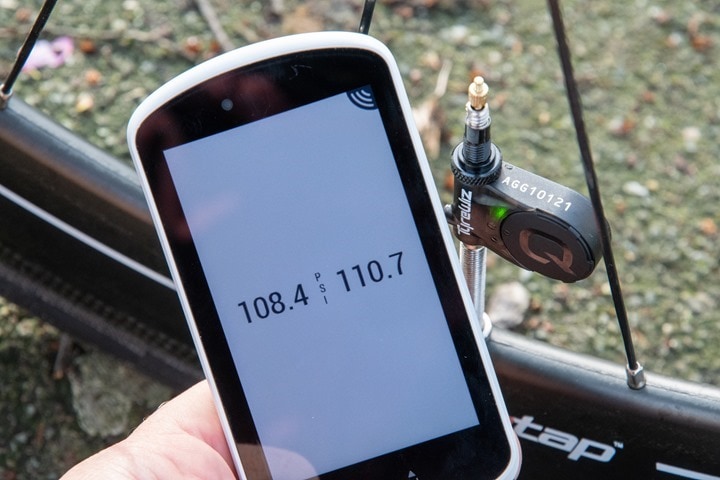
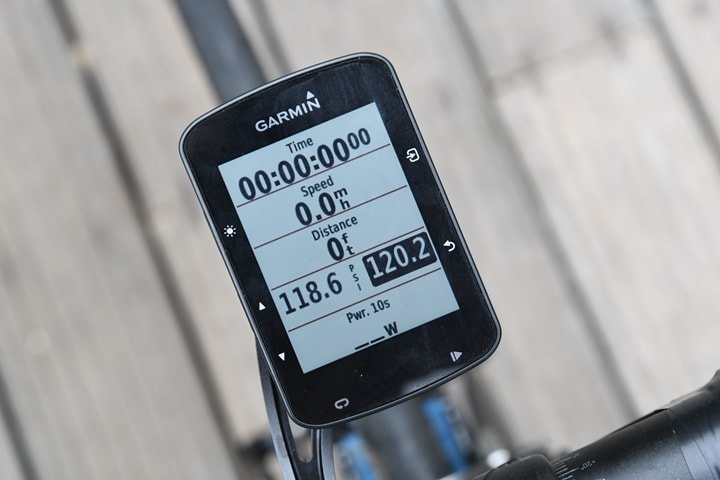

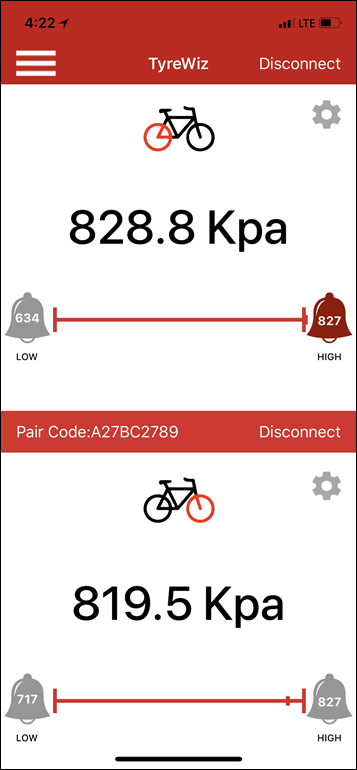
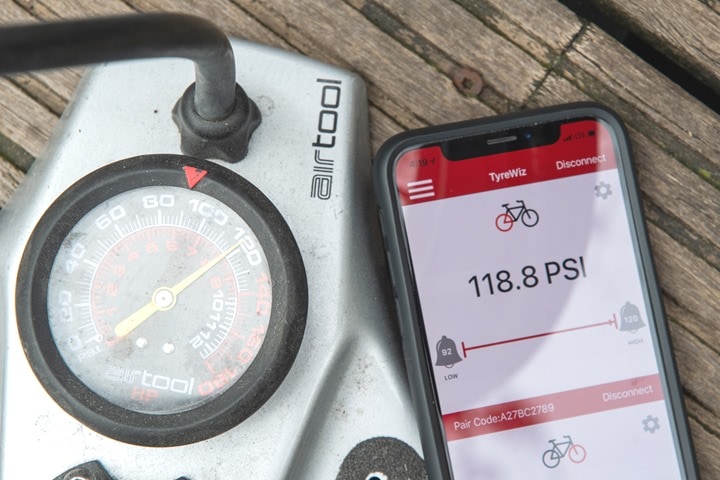
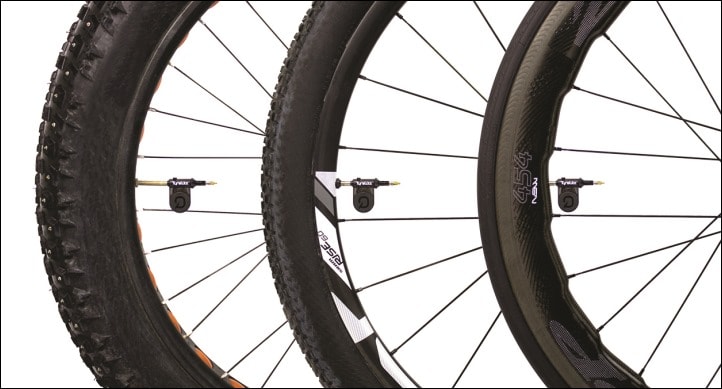
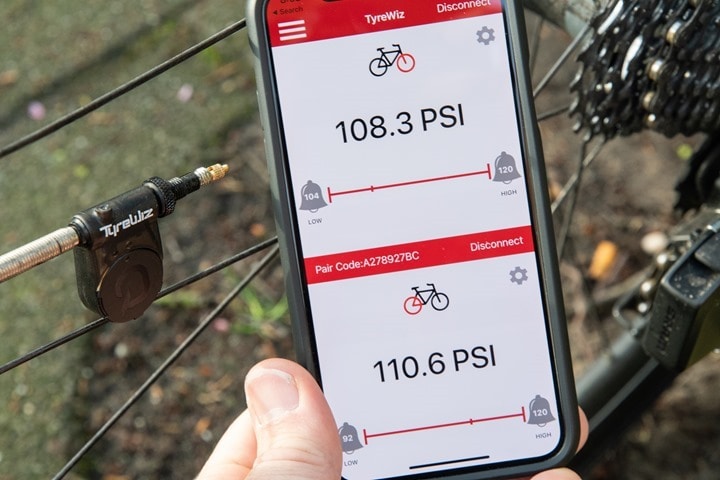





















A solution in search of a problem.
Most cyclists don’t understand how tire pressure can actually dominate ride quality and performance. Finding the right tire pressure and maintaining it daily can greatly improve control, comfort and fun on your ride.
Most people are way to high on tire pressure. As tires trend wider to 25, 28 and 30mm widths it becomes more and more important to find the sweet spot for your conditions.
I just check it before each ride… I do have one of those fancy pants digital tire gauges from SKS though, and I have trended lower as I went to wider tires. About 85 psi on my 26c, and 20-22psi on my 2.25×29.
+1
Completely agree. Of course the guy selling the product says it’s useful, but I wonder how many people are willing to pay $200 for this. Maybe if it cost $20 I’d buy it. I wouldn’t even pay $50 for this product. I don’t race, I just commute to work and go for leisure rides.
Pretty small niche product here.
Finally a product for cyclists suffering anxiety about tyre pressures?
Agreed. Most riders pump their tires before a ride, most pumps have a pressure dial, so… unless you suffer from pressure anxiety as someone else wrote, why oh why?
Yup at 50.00 i’m in. At 20% of a grand….not so much. Cool though !
If they build on top of this, it can be huge in the pro peloton. Imagine if your head unit can send an alarm to your team car when you get a (slow) puncture. It could even add the current GPS location of the rider.
It’s probably not for me but I can think of one more thing to use this for, which is really quite valuable, namely how your ride efficiency correlates with tire pressure. It would sink some of those semi religious discussions.
Lower pressure, higher efficiency :) Hi Tom!
It would be interesting to see how much difference in efficiency we are talking here? Most other cycling gimmicks (like the CeramicSpeed derailleur cage and jockey wheels) offer so little gain you probably wouldnt notice it.
Team Skys “marginal gains” is all well and good if you have their £31000000 annual budget to pay for it.
Very interesting!
Two questions:
1. How rugged does the unit appear to be? Are there concerns about putting too much stress on long valve stems with low profile rims?
2. Can you feel the added weight creating an imbalance with the tire, or is it light enough that you can’t really feel it?
1) It seems rugged to me, but if you managed to get brush into your front wheel spokes at high speed, I could see potential sadness (though, that might be the least of your issues).
2) I didn’t feel it at all.
TyreWiz adds 9.8grams. It is light enough to not cause any noticeable vibration.
One thing I can think of that this would cause problems with is repairing a flat since in order to do that you would need to remove the tire pressure sensor and that will require carrying the special tool and would just add to the time and complexity t takes to change a flat.
I would recommend carrying this little tool anyway as it’s useful to fix loose valves (I wish I had it with me few times). Oh, and it looks like a standard valve tool, nothing out of ordinary.
Note you don’t need the tool to remove the sensor, only to remove the valve stem.
So if you flat, you can easily twist it off in 3-5 seconds. And then you can decide whether to install it on the new tire or not (if you have tool). I think in general in a race situation you wouldn’t bother to re-install it, but just keep it in a pocket/etc..
Good to know and thanks for the clarification.
Definitely useful if the CO2 cartridges are used…I always feel like the tire is going to explode into my face whenever a tire fills.
Garmin solved this a few years ago, but never made the sensor available on their head units: link to buy.garmin.com
Other than being a Schrader valve, it seems like the Garmin option is superior in terms of size and cost. I did see an article somewhere 1-2 years ago where an E-Bike manufacturer hacked these onto it’s concept bike with Garmin’s support.
Any chance that the ConnectIQ fields will support the Garmin product out of the box?
I suspect the challenge is ultimately the valve, as to why the products look so much different. As for the cost…not sure there. It looks like the retail price is/was $69 for a single unit (so $140 total), which is still kinda pricey.
I read more carefully and saw that you state that there is an ANT+ Profile coming. I could have sworn there was already a TPMS ANT+ Profile. Even if I’m right about that, perhaps it was delisted from the ANT+ spec if Garmin was the only company actually offering such a device. (Hard for something to be a “standard” if only one person uses it. :) )
I’d love it to be $50 per unit, but at $70, the Garmin sensor is still 30% less than the Quarq. I really see the form-factor of the Quarq device being a turn-off, whether its for roadies (“Not aero enough”), or mountain bikers (“Too easy to break”). Then again, Quarq aren’t fools, and they certainly have the budget to fix this if my predictions are right.
Tire pressure sensors would work much better if a wheel manufacturer integrated it into the wheel.
Not if its anything like my truck wheels…what a PITA..though mostly in the summer when it gets hot.
Do they have a functional temperature range? And how low of a psi will it register? If it works well at the low extremes of both, it would definitely have some great fat biking applications where there is often a frequent need to air up or down with changing conditions.
I’ll ask about temp range, on PSI it’s virtually zero. I’ve got a video file somewhere showing it from almost nothing up to full.
TyreWiz will run well down to 10*F. It will continue to work below there, but the batteries must be kept fresh. It will measure in 0.1 psi increments down to 0.0 psi (and a bit negative).
We did a bunch of TyreWiz testing on fat bikes this winter. I like F/R 4.5 / 5.8 psi. On a fat bike, you quickly learn that tire pressure inside at 70*F is more than 1psi lower outside at 10*F. So it quickly becomes one of the most important metrics to keep tuned.
Could you please ask Quarq how reliable these are when used in conjunction with tubeless sealant?
TyreWiz is fully sealant compatible. Only one note: do not use a sealant injector and fill sealant directly though TyreWiz. If you use an injector, you should unscrew the sensor and fill directly into the original valve stem.
Otherwise you can use whatever sealant you want in the tire and it wont impact the operation of TyreWiz.
thx for answering the 64k dollar question. the tyrewiz makes most sense for tubeless setups. Might want to make that clearer in your marketing. this goes onto the order list.
199$ to now actual tire pressure? You can purchase accurate floor pumps from 20 bucks!
I’d pay that for a device that could adjust pressure on the fly while riding my mountain bike. Change pressure while going uphill or downhill or when you change from hardpack to loose/muddy terrain.
This raises so many questions… the first of them being: WHY???
The pods looks really flimsy and I would be worried to run them on the MTB but MTB / Cyclocross would be the primary applications that come to mind… and then the tubeless question of how they work long-term with sealant-based tubeless systems and clogging… and why did they make such an ugly package instead of streamlining the design to enclose the valve-stem using a smaller / rechargeable battery?
I would say 100% of their target group have: “taking out ugly reflectors from your wheels and bike”, as step one of making a new bike ready to ride and Quarq put something way uglier in their place…
Many downhill riders obsess over their tire pressure to the .1 PSI, but I cannot see these being on a downhill bike for costs vs. exposure reasons either. Now this is a SRAM sub, so my expectations about the product at market-entry point are a little bit higher than that – they look worse than the Garmin Vector pedal pods, add terrible asymmetry to the bike…
I’m a fan of gizmos and gadgets, but this is… meh.
My concern would be how well does work when running tubeless or when using sealant in tubulars. Will the occasional little bit of sealant that finds its way into the stem and up to the valve core cause problems?
read the comments, quark already answered the question…
This tool may be invaluable for downhill/enduro riders. I wonder though how well it works with tubeless setup and sealant. Valves do get clogged by sealant.
Hey Ray,
My concern on on the MTB side would be the prevailing desire to setup tubeless. Have they said anything about the compatibility of working with a tubeless setup (sealant and all) or is this strictly for a tube setup?
Thanks again for all the great work and information.
Have great time at Sea Otter
Jeremiah
I love gadgets, but even at $99 I’ll pass…
50 euro at the end of the year, and maybe Santa will put a pair in my stockings ;-)
i could really see the benefit for a MTB setup! however the whole sensor looks quite flimsy for a rough MTB environment… make it smaller an a little bit cheaper and I’m sold on it! lookig forward for 2nd gen. ;)
>> Speaking of precision – exactly how much air/pressure do you lose when you take the pump off the valve and you hear that air spit out? The answer as I found out: Almost nothing, well under 1PSI (I suspect the air you’re hearing is actually from the pump, not your tire). I used the app to figure this out. <<
A presta valve loses no air when taking the pump head off. The valve is one-way, and only opens to allow pressure to be added (this is why with the pump off, you must press the plunger to release air. Air pressure in the tire keeps it closed.) The pump head does not hold the valve open. So when you stop adding air, the valve is closed, and when you remove the pump head, 100% of the air you hear escaping is the pressurized air in the hose. Your tires will lose no pressure. If this little gage is showing otherwise, then it is inaccurate.
I’m pretty sure when I did it, it was .1PSI difference that it bumped when I removed it. Which would be within tolerance of accuracy. But I didn’t have video recording at the time.
I’m willing to call that zero. :-)
True that the valve is one direction, but my “gut feeling” is that during the twist and rock needed to remove the pump head with some “snuggy” heads, the valve is kept open and some air flows out.
While it is a very extreme edge case, it would be interesting to see how this paired with data from the AeroPod could affect things. At least for a backyard warrior, with deep pockets, but not wind tunnel deep.
link to flocycling.blogspot.com
As the link above shows, tire pressure can have some affect on aero, and if someone was looking to shave a few seconds, it could help to dial in the perfect setup knowing exact psi at optimal cda.
Ray, since you have both, or will shortly it could be interesting to do some tests like this for us.
In my experience the Aeropod does not offer anywhere near the accuracy you would need to optimize tire pressure for optimal aerodynamics.
What about strava integration? When repairing a flat quickly, can I become King of the Tire?
When a *like* button would be a great thing.
Because I’m a data nerd, I really love this kind of stuff, however I’d prefer it to be cheaper and have an integrated battery –> smaller. I’d definitely love to see the statistics in my winter riding (negative celsius) However I do check my pressure before every ride, so i would be more about the statistics rather than actually using it for checking my tire pressure.
This is cool tech, if a little odd looking. My biking buddies would laugh at me.
Note to Quark: I’d much rather pay $299 for the anodized titanium version to match my hubs.
Or LED lights!!
>> I’d much rather pay $299 for the anodized titanium version to match my hubs.
Atta boy!
I’m with Ken P on this.
They are pretty cool gadgets, but the price/attractiveness ratio is way off :-)
It looks like the oddness of the shape is mostly down to the battery compartment, but if Quark could make some rechargeable ones that look more like the valve extenders we already use with our deep section wheels, I think that could really sell.
(looking more like these: link to zipp.com )
“monitoring only one of your two wheels doesn’t really make a lot of sense.”
What about for wheel-on trainers? The accuracy of my trainer is highly dependent on maintaining my tire pressure within a prescribed range. It would be great to know when I need to re-inflate.
Buy the two and sell the other one to somebody else with a trainer.
I would like to point out that Kpa should be written kPa. The abbreviation of the pressure unit of pascals is Pa and the k meaning thousands is always lower case. The pressure unit of bar should always be written in lower case as well.
That aside I can’t really see the point of this.
This is something we’ve wanted for a while, but haven’t had a moment to build.
Pretty shitty when you use tubeless with milk… in several scenarios
Pair that with the Silca SpeedBalance to counterbalance the added weight: link to silca.cc
The ultimate over the top setup!
If these 10g doohickeys appeal to anyone interested in performance metrics, the Silca SpeedBalance kit will be a required component as Grecko points out. Or Quarq needs to include counterweights in their package.
Watch the Silca video to see why — link to youtube.com
Will it work with 406/20″ Wheels? Can you still get a pump head onto the valve. I have one of those three wheeled devices.
Do I got it right, that it stays on the tire even after pumping up?
Wheel balance will be terrbile! My wheels (with latex inners) are already too heavy at the valves!
Do they have a plan for an mini on-board compressor so that you can adjust the air pressure as you’re riding a la Hummer H1? Now I would see that as a bonus!
But seriously what about weight affecting the wheel balance? I could see sensitivities on a road bike at speed, a downhill for example?
Can you see the pressure spike when you hit a bump?
What about jumping and landing?
Could this be made into a power meter like the Arofly?
Then you could monitor the abuse you are putting on your bike!
I might pick up a set. I see it as a great way to check pressure with a hand or frame pump that doesn’t have a gauge. Very useful for flat repairs.
@Zachary May… Theres no way you will achieve a high pressure with a hand pump. I’d accept its pressure is just a temporary “get you home” measure. Most track pumps, which a more suited to pumping to high pressures quickly and with minimal effort, have a built-in pressure gauge.
@Ben A hand pump designed for high pressure will achieve the same pressure as a track pump, e.g.
link to cycleking.co.uk
Do you know if they plan to combine a speed sensor, that might make it a little more worth it.
Hey Jim@Quarq, is the +/- 2% accuracy spec is of full scale? And what is full scale?
Full scale is 150psi. 2% at full scale is worst case. The 0.1 psi resolution is useful down at single digit pressure.
This gadget actually heightens the anxiety level of people who have anxiety disorder and “I want to have control of everything” people.
When can we finally get some kind of piezoelectric charging in devices like these instead of having to buy and replace batteries? The amount of energy available from these things spinning and bouncing at 20+ mph has to be crazy. Pump that into a small rechargeable and then a transistor to even out the return flow. Then you can waterproof the whole thing and be done with it.
And yeah, like the other guy said – tie this in with that aeropod wind resistance meter and you’ve got a competitive Ironman’s dream package.
I know we love new gadgets and shiny things for our bikes but this seems to have jumped the shark a bit. I would think most people inflate their tires before a ride so are you just guarding against the random time you have a slow leak (which most people would probably continue to ride until it deflated anyway as opposed to immediately stopping)? I am not worried about slow leaks as much as fast ones and I do not need a $200 sensor to tell me that happened……
Full scale is 150psi. 2% at full scale is worst case. The 0.1 psi resolution is useful down at single digit pressure.
Hey Jim@Quarq, thanks for the reply. Please excuse my confusion, but since 150psi x 2% = 3psi, what use is a 0.1 psi resolution if the accuracy can be off by +/-3.0 psi? Wouldn’t that make the sensor practically useless for a fatbike with pressures of F/R 4.5 / 5.8 psi like you mentioned? Also, if you’re trying to compare tire pressures with a friend who also has TyreWiz, you could be at the low end of accuracy tolerance (-2%) and they could be at the high end (+2%), which is a 6.0 psi difference. Am I wrong in all this?
If I understand what you’re getting at….. Accuracy could be off by 3 at 150psi, but that drops to 2 at 100psi, or .1 at 5psi. It’s all relative to the pressure you run your tires at. How many people do you know that run at 150?
Good point other Drew, lol. That actually depends on whether the sensor accuracy is rated at percentage of full scale (% FS), or as a percentage of reading (% RD), see reference below. Jim@Quarq, can you tell us which way the sensor is rated?
link to google.com
Milking the dentists for all they’re worth. Just give your tires a quick squeeze and enjoy the ride.
I’m more interested in what size tire you’re running 100+psi in….
add a chamber that allows me to drop a few psi when I throw the dropper post lever, and add it back when I return to normal seat height….then I might consider it useful.
I can see benefit in finding your optimum set up for efficiency for each wheelset you use; ergo $199 / my triclub = $15 and 5 test rides; over a set course. I’d do that
Whilst I am not sure of the size of the market for something like this don’t forget that rolling resistance is related closely with tyre pressure and with real time aero devices just hitting the market there could be potential there. Aero results need accurate crr values.
So this thing doesn’t suggest what pressures you should run based on performance or anything, just info you input? When I first saw it I assumed it would be like Shockwiz and help you set up personal tire pressure based on average road smoothness on your rides, weight, cornering forces etc but instead it’s just a way of keeping tabs on your pressure?
I like it! I’ve gotten off my bike mid ride before because my tires seemed flat, only to realize it was just my legs that were flat.
Question: can this withstand co2 fill. Seems like things get awfully frosty and I could see that being an issue.
Hey Ray, don’t suppose you know if there’s enough clearance on this to fit in the valve hole of a Zipp Super 9 do you? I’d quite like to use these to monitor in real time the effects of different PSI on CDA values on my TT rig but would need to fit….
Anyone else tried this?
I held one up against a HED Jet Disc wheel’s cutout and there’s no way. I doubt the Zipp wheel is any different.
Nice one, appreciate the reply. Will await v2 then and hopefully they’ll be smaller.
I can see a value in using this data vs power/speed to figure out what your optimal pressure with a given tire might be. Drop the pressure a few PSI and do your favorite test loop to see if it was more work/slower or not. Of course, you could perform the same testing without these pressure sensors and save yourself $200, but seeing it all in charts has some value.
Am I the only one who feels that, for the intended audience, the handlebars on that bike icon in the app are pointing the wrong way?
For some reason, I am now completely annoyed by it :P
The bike has already been re-done in the latest version of the app.
Wow, great! Was that due to comments you made?
Nothing I can take credit for.
They should add a wheel rotation (speed) sensor to the device. That way, you wouldn’t need the separate speed sensor.
Brilliant idea – especially for mountain bike folks who often want a speed sensor for accurate speed/distance.
Claimed battery life is 300h… Does it automatically turn off when not in use? Is there a battery saving function?
I wouldn’t like to change batteries every 15 days…
It’s of actual moving usage (meaning, while the tire is rotating). It goes to sleep otherwise.
That’s 300 hours of riding time.
These sorts of sensors have two modes: an active measurement mode and a very-low power “inactive” mode. The Garmin speed/cadence sensors work the same way.
Weird form factor and excessively accurate. Is there any practical need that couldn’t be solved with a Presta-Schrader adapter and motorcycle sensors for half the price? Something like these link to tirepressuremonitor.com
That’d ultimately be more fugly than the existing solution.
And, it wouldn’t be a solution as it wouldn’t broadcast to any head unit/watch/cycling app on the market. This will broadcast over ANT+ to Garmin head units and Wahoo, which collectively are about 99.9% of the GPS cycling market (actually, Garmin is about 95% of the market, and Wahoo a couple percent).
Ultimately though, what Sea Otter taught me this week is that off-road folks love this (while most on-road folks don’t get it), especially fat bike folks. The number of people that stopped me mid-ride or just walking around the bike was astounding, all of which started with “Where’d you buy that, is it for sale here?”.
looks like you might have to find a fat bike to try single digit pressures off-road. on the road, there are a whole lot of people who talk about pressure in bars, so clearly they don’t even care about single digits of psi, let alone tenths of psi
Problem Would be size and weight for this, i guess. Smallest speed sensor i’ve seen is at Least 4x bigger and heavier than these tire pressure sensors
Most of the people commenting on this saying this is not useful or there is no market for it, realize their is always a market for an item for this. You will have the uber cycling “nerds” or afficionados who are die hard in to their bikes, who will buy this. LIke Dc says, at $99.00 i would buy it at $199.00 i see no need for it at that price. but this will sell.
For those that say there isn’t a market, you’re in the wrong discipline. On my enduro bike I perseverate even a single PSI and change my pressure based on the terrain/course. I just installed a CushCore trying to push that lower limit downward (by improving compliance/traction). If you go too low you risk burping/rolling your tire or damaging your wheel. Too high and you’re wasting traction and off the trail. The margin? Probably a few PSI.
If I had a device that could tell me that last rim hit was legit and I need more air or that I’m not compressing enough I should drop some it would be great. The faster the data/advice the better. Every trail is different, that’s why we MTB! Square hits vary and some trails have no hits at all. 3 PSI could be the difference between railing a corner and ejecting to the rhubarb. Hucking into the rock garden could destroy your wheel or be the best move you’ve ever made, 5 PSI could be the deciding factor.
Now, if it can’t take a hammering it’s of no interest. But if it’s as I the ShockWhiz is, I’m in!
Sign me up!
Having used the original ShockWhiz by Quarq I sure that this piece of kit is going to be well thought out and well engineered.
Next time I have some spare cash I will have to invest in one!
This is one of those inventions that is a solution looking for a problem. As the Tyrewiz isn’t even needed, I’m amazed at its high price.
I quite simply use my track pump (which has a digital pressure gauge) before I go out on most rides. It takes about 5 seconds per wheel. And if I let a bit of air out first, which takes 1 second, theres no way I can over-inflate.
In five years of cycling I’ve never had to check the tyre pressure mid-ride.
If I try to download the APP on my Garmin Edge 520 it says I need to update my device first but when I go to Garmin Express it states that I already have installed the latest software version (Version 11.10.0.0). Any idea how to fix this?
Thanks in advance
Ray, it’s been several months since you wrote this review.
How have the Tyre Wiz held up over the long term? I’m considering buying one to two sets.
Do you still like them? What issues have you found? Are there any other choices?
Thanks
-marc
I like them, and by and large continue to test/use them just like I did initially – which is more as a quick check of tire pressure both pre-ride and during the ride (usually when I’m feeling slow).
One nifty trick I didn’t realize/know about till last week at Eurobike was that the little LED lights on them actually tell you pressure status. The idea being you don’t even need to look at your head unit when you walk up to your bike. Simply spin the wheel and if it blinks green it’s in the pre-defined zone you set, and red it’s not. Brilliant.
Oh, and I should point out I still think they’re too expensive and need to be half the cost.
Thanks Ray.
The pair sells for $200 from Clever Training.
I’m notoriously bad at checking and filling tires. I even have an issue on my car. However, my car tells me when it gets too low.
-marc
Ray, what tube, if any, do you use?
I have tubes by Kendra and they look like the value stem is a one piece unit.
So, if I decide to get the Tyre Wiz, I would need to get new tubes.
Nice…I completely forgot to add in the Clever Training links, since I think they only started accepting orders for it semi-recently. Heck, I even got so organized as to add in the Amazon links too! A twofer!
As for your question – I don’t think you’ll actually need new tubes. The tubes undoubtedly look like one piece, but ultimately they do separate with the tiny little tool inside (or, with just a wrench). The first time you do it you’ll be like ‘I don’t think this is going to end well for this tube’, but once you do – you see a whole new side of valve stems you’ve never seen before.
On the specific tubes I use, it’s just whatever the bike shop has that has the right valve length for the wide rimmed aero wheels I usually ride.
Thanks.
I’ve ordered the Park Tool VC-1 so I can check my valves before I invest in the Tyre Wiz.
If it blinks red and slow, the pressure is too low; if it blinks red and fast, the pressure is too high.
Anyone get this to work with the Garmin 520 Edge Plus? In the Connect IQ store the TyreWiz Data Field states it’s not compatible and you can’t download or install it. Thanks in advance.
Does the Connect IQ data field also give an audible alarm for the low (or high) threshold set?
Maybe this would have helped me today. Almost had huge accident on steep downhill descent with sharp turns and massive drop-off past guardrail due to front tire slowly deflating. Braked like usual for sharp turn but tire rolled when leaning into turn and rim scrapped the ground as the bike was sliding a little sideways. Tire held enough air to limp home 3 miles but had to take turns at a craw due to low tire pressure. Wonder if tire pressure was okay at top of hill. If I had this sensor, I could have checked.
The reason I’m here is that last Tuesday I turned into a nice hard right-hander at 42.1 kmh and the front wheel let go. I’ve been round that corner maybe a hundred times, and all the while I was in the hospital I was wondering why – the road was dry, I didn’t think I’d hit any sand . . . and then when I got home I checked and the front tyre was flat, yet my wife said it wasn’t when she put it in the car.
Dislocated shoulder, destroyed helmet and jersey, major pain and suffering, off the bike for maybe a month, my introduction to Ketamine. (Ketamine: a cross between acid and shrooms, squared. Not that I’ve taken either. Not recommended at all. But there was No Pain, a major reduction from the 9/10 I had had.)
I reckon $300 Aussie would be a bargain.
Hello,
When is the long term review coming up? I am interested in seeing data on how pressure changes throughout a ride. From cold to fully warmed up and with some various levels of braking.
Thanks!
Yeah, it’s on my to-do list.
In a funny way, I almost have too much data from it now. Meaning, I take it on every ride/etc, so gotta figure out which rides to look at from a historical standpoint and what conclusions to draw from it.
We’re just having an argument on ST. It appears a 5 psi difference can significantly impact wheel/tire drag results based on some manufacturer’s tests (flo). I’m postulating variability in tire pressure from cold inflation through a typical ride due to temperature changes inside the tire from hysteresis as well as braking might be such that you really can’t account for it. Hopefully I’m wrong and we can come up with an avg psi you should set your cold presure to before a race, but I thought your data might shed some light on this.
Hi there,
What is your opinion on how safe the device is for MTB while riding. Is it tucked away enough not to get bashed around much or fall out/off?
thanks.
I ended up getting a pair, installing them now. Who knows whether I will find it really useful, but it is pretty neat. I have the PSI displayed on the AeroPod screen to see if I can figure out impact of tire pressure on speed/efficiency/position. Probably two many variables but fun to experiment.
Too not two, but maybe pun intended.
@Mark M. How are you liking the Tyre Wiz? I just got a set. Arrived last night. Haven’t installed them yet.
I’m a bit on the fence as to whether it would make sense for me. It stands it took me 30 minutes to change a tube last Saturday. The cold temps in the Northeastern US doesn’t make it fun to be outside and have your gloves off fighting with a tire to get it off the rim so you can get to a tube.
Using the Tyre Wiz means I now need to carry a valve core tube and fight with that also, even if I”m just taking the Tyre Wiz unit off and not re-installing until I get back home.
I have 45 days to make up my mind as long as I don’t open the packaging.
What has your experience been like?
Thanks
-marc
This plot shows a real life punkture recorded with tyrewiz…
Tyre: Schwalbe pro one TLE evo microskin 25mm.
Sealant: Joes no flats Road racing sealant.
So if using this device for performance/competition what would you do at that point?
Slam on your brakes, yank out the CO2 cartridge, and top off back to 70 psi?
Or calculate distance remaining vs speed loss due to pressure/resistance difference and soldier on? :)
Just kidding although I am sure someone out there will try to do the math.
Let’s see — might lose 1.6 sec/mile, 32 miles left, that’s 51 seconds, better stop and top off quickly.
DCR — Did this product never advance from Hands-on to In-Depth?
I’m actually very interested in purchasing these. We bike in the Santa Cruz Mountains and have had tires explode. With lowered pressure, there is always the danger of the tire rolling off the rim. It would be good to visualize pressures. This is ultimately, or could be, a great safety feature. I am wondering if Quarq is going to upgrade these as they’ve been out for awhile. Also with Sea Otter coming soon are they going to lower the price or announce an upgrade? I would like to see them go to a titanium body with the money they are charging.
After looking at the app in Connect IQ I’m wondering if they are discontinuing this product. Lots of bad reviews. Looked at the Quarq site and they are discontinuing their phone app. I called Quarq and ask if they have them in stock and they did but the person on the phone wasn’t enthusiastic. My internal feelings tell me to stay away from this one.
I’ve decided to wait for the Hutchinson monitor which was supposed to be released Q1 2019. In my opinion it better fits what I need and won’t require dismantling something to fix a flat. I like their approach using pressure inside the tire instead of mounting a device on the stem. Anyway for right now I have saved my $200.00 and will wait.
How cool was that having a full Car diversion System the best 6×9 speakers Through this I really makes the most of my ride each time uniquely while out and about with a few companions. So amazing!
Anyone ever tried to connect to Garmin Fenix 5 Plus? I am having issues only with the watch, Wahoo bolt and Garmin Edge works….
SKS now has the Airspy (AV and SV version for two different valves) – at your sweetspot price of 99Eur the pair – to be found on the market by about 80Eur/pair. Any thoughts/ideas/insights on this one?
So, for anyone still interested, I looked into Airspy vs. Tyrewiz. From what I can find online, and from emailing SKS support, I found these differences:
1. Airspy’s Garmin Data field doesn’t store data in the .fit file. So if you want to be able to analyze how different tire pressure affects power output, for example, you have to get Tyrewiz. When asking support about it, I got a bullshit answer that it’s hard to get Garmin to allow them to write anything to the .fit file. When hundreds of hobby-developers can make Connect IQ apps and data fields that stores data, it can’t be very hard for a big company, unless their developers are completely incompetent. (My opinion/thoughts.)
2. Airspy is slightly bulkier, and double the weight (maybe a little more, since you remove the valve core when installing Tyrewiz). On the positive, Airlspy attaches to a spoke to keep it securely in place. They call it “theft protection”, but that’s obviously a load of mumbo-jumbo.
3. Tyrewiz has a led that will tell you if you’re within target pressure without looking at your Garmin or phone. The led supposedly turns off when the tire rotates. And of course when the unit goes to sleep after a few minutes without movement.
4. You can set the target pressure range in the Tyrewiz app. For Airspy, it’s 15 and 25% over/under (15% is orange, 25% is red in the app). Tyrewiz also will show in the Garmin data field if it’s outside range.
5. Airspy doesn’t specify battery life. I found a German video review, where the guy had used it for 6 months. In the video, he says the battery lasts only 1 to 1½ months, and he rides about 1000-1200 km a month. 1200 km at 20 km/h (he rides a mountain bike) would be 60 hours. Tyrewiz specifies about 300 hours, but I haven’t found any long term reviews. In one Youtube review I found, the guy said he used up the battery that came with the unit, and that he expected a new battery to last longer.
6. Airspy is half the price (in Europe).
7. Tyrewiz is rated to 150 psi max pressure. Airspy is rated to 120. I have seen some user reviews that Airspy can’t handle road bike pressures in the 90-100 range. I guess it depends on the valve, and of course it can be user error as well.
8. Airspy is newer, so it might be supported for longer (app updates, chances of a Wahoo data field in the future etc.). This is pure speculation.
So, in my opinion, they are about equal when it comes to price/value. You get what you pay for. In my case, I would never buy such a “unnecessary” product without getting the most possible out of it, which includes the ability to nerd out in front of the computer and see if tire pressure affect time, speed or power output. Then again, 200€ is steep.
A question for Ray or anyone else who has tried Tyrewiz: Does it blink green if inside target range even if it’s NOT connected to a Garmin or phone? Or does it blink red or orange to show it’s not connected?
Cheers
Audun
Hey Audun,
fantastic write-up. thanks for the info!
I did not know that the Airspy does not write in the fit file, seeing this its not really interesting anymore.
Thanks!
You’re welcome, Steffen, glad to help.
Now, remember, this is only based on information I could find online, as I have not tried any of them.
I agree, not writing to the .fit file is a total dealbreaker!
Cheers,
Audun
Tyrewiz – interesting product though kinda spendy. The Airspy looks interesting as well.
PSIcle is another electronic tire pressure that does not use a battery and weighs only 5 grams. It’s a Kickstarter campaign that recently launched – the pricing is $52 for 2 sensors. I almost never invest in Kickstarter products due to the uncertainty – but this product looks interesting and I was impressed with the inventor’s background.
I had a look at the PSIcle campaign page. It’s not really a competitor to the Tyrewiz and Airspy, it’s more of a competitor to a digital pocket gauge. You have to get off the bike and hold your phone near the valve, so a lot faster and easier than a pocket gauge, but it’s not the same as having the pressure live on your Garmin Edge. Will do for checking the pressure before and during a ride, though 🙂
Cool idea, thanks for sharing it!
Cheers,
Audun
Ray, do you have any details on what looks like a new version of the TyreWiz? ZippSpeed just posted a pic on Twitter and there is one shot of it on the SRAM web site. It has a much better (IMHO) form factor where the “capsule” is flat on the wheel rim.
It looks like the Tyrewiz-for-Moto integrated system that’s been around since 2019. I agree it seems a better form factor, but perhaps it would need a different base for each rim profile.
link to twitter.com
Thanks Jeff. I had not seen the Moto before. I would think they could solve the rim profile issue by supplying three or four rubber adapters the way they do with seat post mounted lights.
One potentially useful application for TireWiz is on tandem bicycles running rim brakes or heavy loads in hilly environments. It’s a significant safety issue to avoid overheating the rims and blowing a tire off on a long braking descent; ask me how I know. Since pressure is proportional to (absolute) temperature, you can monitor the effective rim temperature by watching how the tire pressure changes during braking descents. Note that “absolute temperature” means Kelvins (K) in the metric world (nobody uses Rankine, the English equivalent, these days). Room temperature is about 300 K (27 degrees C or 80 F, approximately). So, for example, if you see your tire pressure increase from 100 psi to 120 psi on a long braking descent, that means the rim temperature is 1.2 * 300 K = 360 K, or about 87 degrees C, or 189 F. This is about as high as you’d want to go in most situations to maintain an adequate safety margin. NB: In my experience, the limiting factor is usually the rim strip, not the tire or tube. Always use cloth (Velox type) rims strips as they’re the most resistant to high temperature. Hope this helps to keep you safe out there!
I think when you say “stem” you mean “core “
I think this would be invaluable in an IM where exhaustion can lead to a lack of awareness, and where a unnoticed loss of tire pressure can lead to poor handling = potential accident. It’s also almost impossible to see if the tire is full in when riding my TT bike. Ill be buying one of these.
Has anyone tried to use the “QUARQ TyreWiz ZIPP 303 FIRECREST” version on a non-Firecrest rim of similar height? The form factor and looks of this version is so much better than the standard version ;-)
I guess this variant also hasn’t made it? Any reason known?